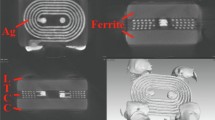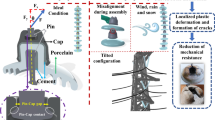Abstract
The press-in terminal is a special-shaped cross-section suitable for press-in connection. According to the different design of the press-in connection, the press-in connection is divided into two processes: solid press-in connection and flexible press-in connection. This paper mainly analyzes the requirements of the PCBA flexible solderless press-in connection process introduced in the DCS safety equipment of nuclear power plants, identifies the key control requirements. The test items are determined by the design of the application scheme, and various forms of tests are conducted. The data of test is obtained. Based on the test results analyzed, the reliability of the flexible press-in connection process implementation is verified, which laid the foundation for the application of the later flexible press-in connection process, and can also form a set of evaluation methods for the flexible press-in connection process.
Access provided by Autonomous University of Puebla. Download conference paper PDF
Similar content being viewed by others
1 Background Introduction
The PCBA solderless press-in connection technique is fitting the elastic deformable pins or rigid pins into the metallized holes of PCB, to form close contact between the pins and metallized holes, and realize electrical connection by mechanical connection. The continuous development of electronic products has put forth daily increasing requirements on product consistency and high density. Compared with soldering, the features and advantages of press-in connection are embodied in: no thermal stress produced on the PCB; no conducting substance such as residual flux or solder bead left that may affect reliable connection; determined contact impedance and good high frequency performance; high efficiency and low cost; and good maintainability. It is already not possible to do soldering for small connectors with fine spacing and multi-row pins with previous techniques, and the press-in connection technique has been widely accepted and applied for its very high reliability and easy operation. Today, PCBA solderless press-in connection technique has been widely applied in products with high reliability requirements (such as military industry, railway and automobiles); in view of its advantages, the PCBA solderless press-in connection technique has also been adopted by CTEC in the devices of nuclear class digital I&C systems.
According to the analysis in HAF601 and HAF003 on the process control requirements for safety class cards [1, 2], the reliability of PCBA solderless press-in connected products mainly depends on the technical fitting of press-in connection ends and the PCB before plating, and visual check alone is not sufficient to verify its reliability, therefore, a set of objective and effective type test methods is required for the assessment.
2 Demand Analysis
At present, the technical requirements of the electronic assembly industry on PCBA solderless press-in connection are mainly based on: the international standard IEC 60352-5:2012 Press-in connection - General requirement, test methods and practical guidance and the Chinese national standard GB/T 18290.5-2000 Solderless connections - Part 5: Solderless press-in connections - General requirements, test methods and practical guidance, and in summary, the main requirements include the following:
Press-in connection equipment. The equipment needs to fully control the pressure, press-in distance and speed, to ensure correct application of these factors for different products.
Press-in connection ends. It is confirmed in design type selection that the materials, dimensions, surface coating and structural characteristics of the connection ends (connection elements) comply with the requirements in GB/T 18290.5-2000, however, the reliable fitting of the PCB and plated holes shall be assessed for the connection elements after completion of press-in connection.
PCB and plated holes. The PCB thickness is the basic guarantee for the press-in connection strength, and the required thickness is 1.5–6.4 mm [3]; for the plating layer and dimension of plated holes, the specific range of parameters are given in the Chinese national standard and IEC standard, and they are also important to ensure the stability of press-in connection technique. For the detailed requirements, refer to Table 1 Requirements on plated holes [3].
3 Application Scheme Design
According to the technical requirements on PCBA solderless press-in connection, automatic press-in connection equipment was used, with the working mode as automatic adjustment of press-in travel and force after it is set at the constant press-in speed; the whole press-in operation was performed automatically and the press-in force values are recorded in the computer. After the completion of press-in, no damage to the press-in end or PCB was found in visual check, however, whether it could provide reliable connection depended on the result of type test.
The PCB thickness is 3 mm, the plated hole material is copper, plated on surface with tin, and the hole diameter range after plating complies with the requirements in the national standard.
The test samples of press-in connection elements were in three types, but with the same connection end type as “needle hole” of 0.3 mm, and all in copper alloy. According to the IEC standard, the connection end manufacturer provided the maximum press-in force of the devices as 100N, and all test items in the application test were conducted according to IEC 60352-5: 2012 a [4], to verify the effectiveness and reliability of this press-in connection end.
The above analysis showed that all indicators in the test met the requirements in the national standard, and can meet the process verification in the basic test. The process flow of the test is as shown in Fig. 1 Test items and process.
Microscopic check of connection points after press-in connection is not required in the national standard, however, according to the analysis of the process control requirements in HAF003 of the nuclear power industry [2], and with reference to the requirements on press-in connection points in IEC 60352-5:2012, the metallographic section inspection was added, and the test process is as shown in Fig. 2 Test items and process.
4 Verification Results of PCBA Weldless and Pressed-In Connection
First, the sample appearance check was made, the result: no obvious physical damage, no burr or crack in the shell/side jacket, and the connector plugs and pins were all straight.
Next, some samples were tested for push-out force to detect the mechanical strength in the initial state after press-in connection. The target value was no less than 10 N/pin. The values may vary for different types of terminals, and in standards, it is required that the values shall be provided by the terminal manufacturer. For specific analysis of test data, refer to Table 2 Push-out test value.
The contact resistance was tested twice, respectively before and after rapid temperature change, the change of data of the samples were tested before and after the external environmental stress is applied, to determine whether effective electrical connection still remains at the press-in connected contact, to verify its long-term reliability. The PCBs used this time were formal product of nuclear safety class, and the electrical connections at multiple points form volumetric resistance, therefore it was not possible to accurately measure the contact resistance of individual press-in connection points, and the analysis was focused on the change of resistance value before and after the temperature cyclic change. For specific analysis of test data, refer to Table 3 Contact resistance test value.
Then comes the last item of the test, the push-out test after rapid temperature change. The same principle applies, to test if the connection points can meet the requirements a period of time after the environmental stress is applied, to verify the long-term reliability of mechanical connection. For specific analysis of test data, refer to Table 4 Push-out force test value after rapid temperature change.
In addition, some samples were used for metallographic section examination. According to the guidelines of IEC standard, transverse and longitudinal slicing was made on press-in connection part respectively, and values were measured and the microscopic condition of the plated hole wall observed, for detailed data analysis conclusions, refer to Fig. 3 Metallographic sections.
5 Verification Conclusion on PCBA Solderless Press-in Connections
Through the above various forms of test data analysis, the reliability of the implementation of the solderless press-in connection process is verified; later, it can be combined with the actual product process requirements and established a set of evaluation method for connection reliability of PCBA solderless press-in type equipment in the DCS safety level equipment of nuclear power plants.
References
State Environmental Protection Administration: HAF601 Regulations on the Supervision and Management for Design, Manufacturing, Installation and Non-Destructive Test of Civilian Nuclear Safety Equipment (2008)
National Nuclear Safety Administration.HAF003 Code on the Safety of Nuclear Power Plant: Quality Assurance. Atomic Energy Press, Beijing (1991)
State Bureau of Quality Technical Supervision: GB/T 18290.5-2000 Solderless connections - Part 5: Solderless Press-In Connections - General Requirements, Test Methods and Practical Guidance
International Electrotechnical Commission: IEC 60352-5:2012 Press-in Connection - General Requirement, Test Methods and Practical Guidance (2012)
The Institute of the Interconnecting and Packing Electronic Circuit: IPC- A- 610 Acceptance conditions for electronic assemblies
Author information
Authors and Affiliations
Corresponding author
Editor information
Editors and Affiliations
Rights and permissions
Copyright information
© 2021 The Author(s), under exclusive license to Springer Nature Singapore Pte Ltd.
About this paper
Cite this paper
Liang, ZQ., Li, JG., Zhang, RF., Wang, LC. (2021). Reliability Assessment Research and Application for PCBA Solderless Press-In Connection Technique in DCS Safety Class Devices in Nuclear Power Plants. In: Xu, Y., Sun, Y., Liu, Y., Gao, F., Gu, P., Liu, Z. (eds) Nuclear Power Plants: Innovative Technologies for Instrumentation and Control Systems. SICPNPP 2020. Lecture Notes in Electrical Engineering, vol 779. Springer, Singapore. https://doi.org/10.1007/978-981-16-3456-7_47
Download citation
DOI: https://doi.org/10.1007/978-981-16-3456-7_47
Published:
Publisher Name: Springer, Singapore
Print ISBN: 978-981-16-3455-0
Online ISBN: 978-981-16-3456-7
eBook Packages: EnergyEnergy (R0)







